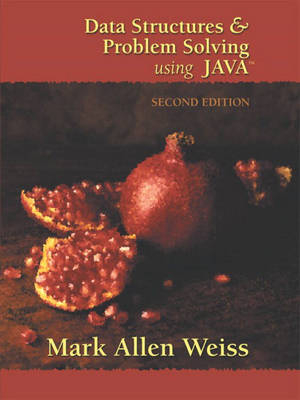
Data Structures and Problem Solving Using Java
Pearson (Verlag)
978-0-201-74835-2 (ISBN)
- Titel erscheint in neuer Auflage
- Artikel merken
Data Structures and Problem Solving Using Java, Second Edition provides a practical introduction to data structures and algorithms from the viewpoint of abstract thinking and problem solving, as well as the use of Java.
This text has a clear separation of the interface and implementation to promote abstract thinking. Java allows the programmer to write the interface and implementation separately, to place them in separate files and compile separately, and to hide the implementation details. This book goes a step further: the interface and implementation are discussed in separate parts of the book. Part I (Tour of Java), Part II (Algorithms and Building Blocks), and Part III (Applications) lay the groundwork by discussing basic concepts and tools and providing some practical examples, but implementation of data structures is not shown until Part IV (Implementations). Class interfaces are written and used before the implementation is known, forcing the reader to think about the functionality and potential efficiency of the various data structures (e.g., hash tables are written well before the hash table is implemented).
(Each Chapter concludes with a “Summary,” “Objects of the Game,” “Common Error,” “On the Internet,” “Exercises,” and “References.”).I. TOUR OF JAVA.
1. Primitive Java.
The General Environment.
The First Program.
Primitive Types.
Basic Operators.
Conditional Statements.
Methods.
2. Reference Types.
What Is a Reference.
Basics of Objects and References.
Strings.
Arrays.
Exception Handling.
Input and Output.
3. Objects and Classes.
What Is Object-oriented Programming?
A Simple Example.
Javadoc.
Basic Methods.
Additional Constructs.
Packages.
A Design Pattern: Composite (Pair).
4. Inheritance.
What Is Inheritance?
Designing Hierarchies.
Multiple Inheritance.
The Interface.
Fundamental Inheritance in Java.
Implementing Generic Components.
The Functor (Function Objects).
Dynamic Binding Details.
II. ALGORITHMS AND BUILDING BLOCKS.
5. Algorithm Analysis.
What Is Algorithm Analysis?
Examples of Algorithm Running Times.
The Maximum Contiguous Subsequence Sum Problem.
General Big-Oh Rules.
The Logarithm.
Static Searching Problem.
Checking an Algorithm Analysis.
Limitations of Big-Oh Analysis.
6. The Collections API.
Introduction.
The Iterator Pattern.
Collections API: Containers and Iterators.
Generic Algorithms.
The List Interface.
Stacks and Queues.
Sets.
Maps.
Priority Queues.
7. Recursion.
What Is Recursion?
Background: Proofs by Mathematical Induction.
Basic Recursion.
Numerical Applications.
Divide-and-Conquer Algorithms.
Dynamic Programming.
Backtracking Algorithms.
8. Sorting Algorithms.
Why Is Sorting Important?
Preliminaries.
Analysis of the Insertion Sort and Other Simple Sorts.
Shellsort.
Mergesort.
Quicksort.
Quickselect.
A Lower Bound for Sorting.
9. Randomization.
Why Do We Need Random Numbers?
Random-number Generators.
Nonuniform Random Numbers.
Generating a Random Permutation.
Randomized Algorithms.
Randomized Primality Testing.
III. APPLICATIONS.
10. Fun and Games.
Word Search Puzzles.
The Game of Tic-Tac-Toe.
11. Stacks and Compilers.
Balanced-Symbol Checker.
A Simple Calculator.
12. Utilities.
File Compression.
A Cross-reference Generator.
13. Simulation.
The Josephus Problem.
Event-driven Simulation.
14. Graphs and Paths.
Definitions.
Unweighted Shortest-path Problem.
Positive-weighted, Shortest-path Problem.
Negative-weighted, Shortest-path Problem.
Path Problems in Acyclic Graphs.
IV. IMPLEMENTATIONS.
15. Inner Classes and ArrayList Implementation.
Iterators and Nested Classes.
Iterators and Inner Classes.
The AbstractCollection Class.
Implementation of ArrayList with an Iterator.
16. Stacks and Queues.
Dynamic Array Implementations.
Linked-list Implementations.
Comparison of the Two Methods.
The java.util.Stack Class.
Double-Ended Queues.
17. Linked Lists.
Basic Ideas.
Java Implementation.
Doubly Linked Lists and Circular Linked Lists.
Sorted Linked Lists.
Implementing the Collections API LinkedList Class.
18. Trees.
General Trees.
Binary Trees.
Recursion and Trees.
Tree Traversal: Iterator Classes.
19. Binary Search Trees.
Basic Ideas.
Order Statistics.
Analysis of Binary Search Tree Operations.
AVL Trees.
Red-Black Trees.
AA-Trees.
Implementing the Collections API TreeSet and TreeMap Classes.
B-Trees.
20. Hash Tables.
Basic Ideas.
Hash Function.
Linear Probing.
Quadratic Probing.
Separate Chaining Hashing.
Hash Tables Versus Binary Search Trees.
Hashing Applications.
21. A Priority Queue: The Binary Heap.
Basic Ideas.
Implementation of the Basic Operations.
The buildHeap Operation: Linear-Time Heap Construction.
Advanced Operations: decreaseKey and merge.
Internal Sorting: Heapsort.
External Sorting.
V. ADVANCED DATA STRUCTURES.
22. Splay Trees.
Self-Adjustment and Amortized Analysis.
The Basic Bottom-Up Splay Tree.
Basic Splay Tree Operations.
Analysis of Bottom-Up Splaying.
Top-Down Splay Trees.
Implementation of Top-Down Splay Trees.
Comparison of the Splay Tree with Other Search Trees.
23. Merging Priority Queues.
The Skew Heap.
The Pairing Heap.
24. The Disjoint Set Class.
Equivalence Relations.
Dynamic Equivalence and Two Applications.
The Quick-Find Algorithm.
The Quick-Union Algorithm.
Java Implementation.
Worst Case for Union-by-Rank and Path Compression.
APPENDICES.
A. Operators.
B. Graphical User Interfaces.
| Erscheint lt. Verlag | 31.8.2001 |
|---|---|
| Sprache | englisch |
| Maße | 195 x 243 mm |
| Gewicht | 1567 g |
| Themenwelt | Informatik ► Programmiersprachen / -werkzeuge ► Java |
| Mathematik / Informatik ► Informatik ► Web / Internet | |
| ISBN-10 | 0-201-74835-5 / 0201748355 |
| ISBN-13 | 978-0-201-74835-2 / 9780201748352 |
| Zustand | Neuware |
| Haben Sie eine Frage zum Produkt? |
aus dem Bereich



